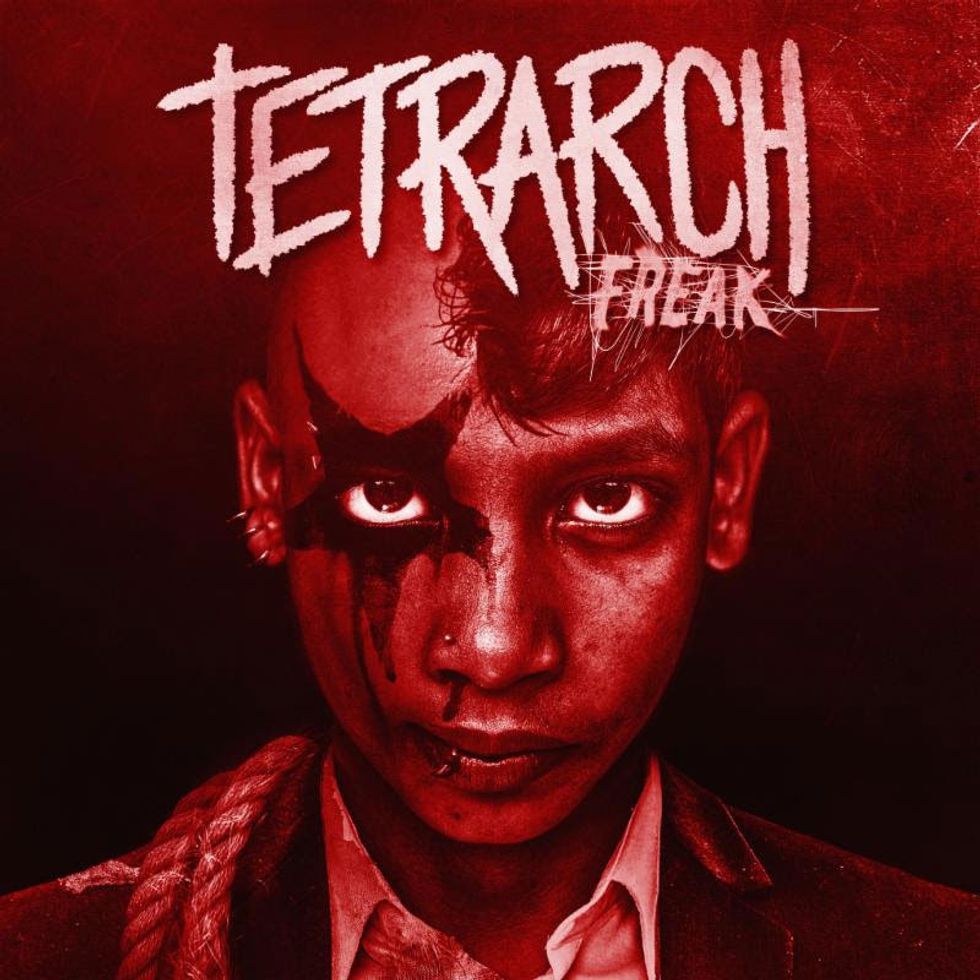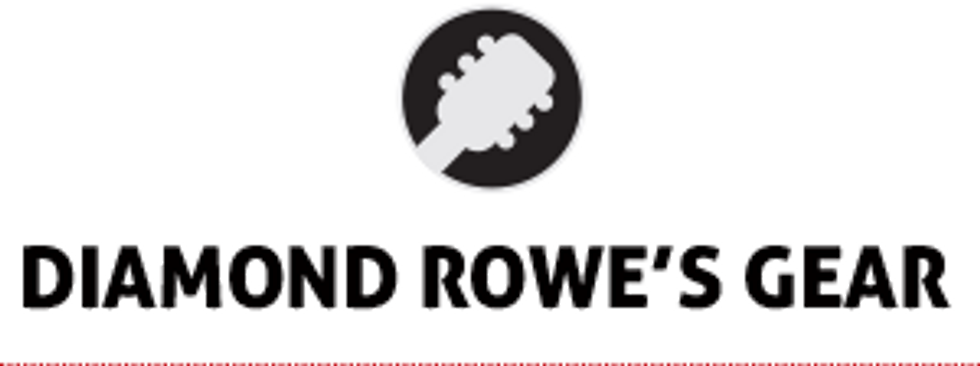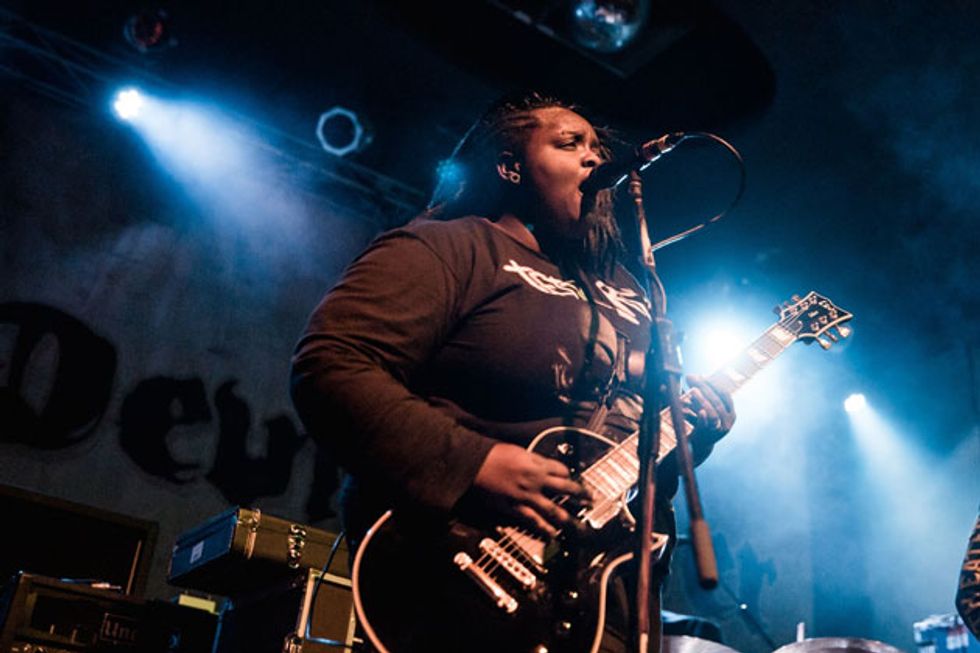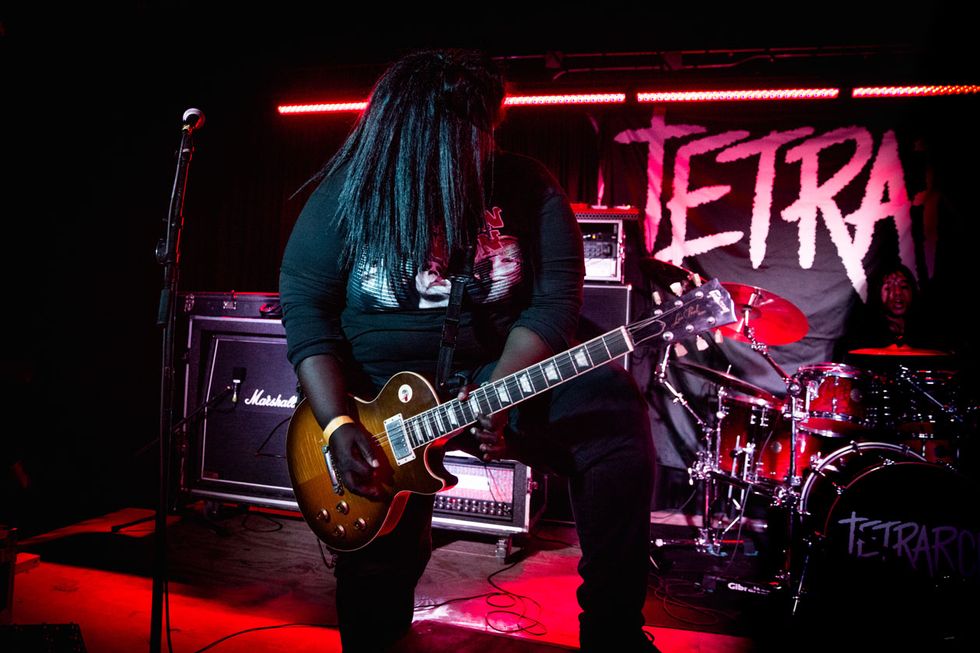Some guitarists suffer from a compulsive need to acquire gear. As in, more gear—always more. Too much is never enough.
Is that you?
Symptoms include: a pedalboard that’s in constant flux, an overdrive that’s good, but not good enough, swapping out pickups more frequently than a golfer swaps clubs, and owning too many guitars (as if that’s even possible).
But, and this may come as a shock, that’s not every guitarist. Some are content with the gear they have. They like their sound. And—this is huge—some guitarists are even resistant to change.
Mind blown?
Diamond Rowe, the lead guitarist in the hook-driven, melodic metal outfit Tetrarch, falls into that second category.
“I am one of those types of people,” she says. “I get emotional connections to my gear. The idea of switching my rig around gives me so much anxiety.”
It’s not that Rowe isn’t a gearhead. She is. But she knows how to get her tone. Rowe sticks with tools that work, even if that means sticking with unorthodox workarounds. For example, the staple of her sound is an always-engaged Ibanez Tube Screamer in front of a Mesa/Boogie Triple Rectifier. “I always use that third channel,” she says about her amp. “I would be lying if I said that I ever switched it. That third channel is on 99.99 percent of the time. But the only way I get it to be exactly how I want is to use the Tube Screamer, the TS9, on top of it for rhythms. My TS9 is always on.”
But for Rowe, that conservative streak ends with her live rig. In the studio, she’s open to anything—different amps, amp modelers, new effects—whatever works. “I like to try different things,” she says. “Let’s give this a shot. Let’s give that a shot.”
That adventurousness applies to her playing, which is still evolving, as well. Her roots are in thrash metal and her natural tendency is to shred, but Freak—Tetrarch’s latest release and first full-length album, which follows three EPs—showcases her melodic side. Her solos are song-appropriate, tuneful, and shorter than on previous efforts, all by design.
Premier Guitar sat down with Rowe to discuss her practice techniques, tunings, new ESP LTD 7-string, and her approach to crafting soundscapes. She also explained why the Peavey 6505 is her secret ingredient for recording modern metal rhythm guitar. And, of course, we discussed her reticence toward new gear.
When did you start playing?
The day I turned 12 was the day I had my first guitar lesson. I’d just gotten into heavier music. I was listening to pop and hip-hop before. I started getting into Nirvana, Pearl Jam, System of a Down, and stuff like that. Metallica is my all-time favorite band and I started getting into Metallica at that time.
And you took lessons.
I did, for about a year. It helped me jumpstart my learning process. I never really had an awkward phase with guitar, which I’m glad about. It always felt natural to me. Lessons taught me how to read tabs, different chords, and different techniques like palm muting that I wouldn’t have known myself. Also, my parents bought me mounds and mounds of tab books at Guitar Center. I would learn my favorite bands’ songs all day, every day. I would say that’s mainly how I learned guitar.
What is your practice regimen like?
It’s a bummer, because I’m so bad at practicing the correct way. Usually when I practice, it’s either learning a song, warming up, or getting my chops up. I don’t do a lot of scales or exercises. Rather, I’ll take some of my favorite lead guitar players—like Dave Mustaine—and I’ll go to one of his harder solos, sit at home, and tinker with that for a while. As weird as it sounds, when you go to play your own stuff, it helps a lot by practicing off other people that you learn from. It keeps it fun for me because otherwise it gets a little boring. I’m not the exercise type. I wish I was, but it keeps it fun for me to learn things that I’m familiar with but that may also be making me better.

TIDBIT: Rowe says her secret weapon for getting kick-ass metal tone is the Peavey 6505, which she used on Freak and the band’s most recent EPs.
A lot of your music is very fast. How do you keep up your stamina over the course of a long set?
Well, it’s funny, but it’s harder for us to come up with things that are slower and more mid-tempo. When we started, Metallica was our favorite band. Or Testament. It was thrash bands. Now we’ve moved on and our influences come from different places—bands like Korn or Linkin Park—stuff that’s not as natural for us to play. So, the faster stuff is easier for me to play without warming up. But the slower stuff, the more melodic stuff, that’s more like, “Man, I need to practice this a bit and warm up.”
What’s harder about the slower stuff?
More feel; your vibrato. Vibrato is something that took me a while to be good at. A lot of guitar players will tell you that it’s harder than you would think. Guys like M. Shadows from Avenged Sevenfold have great vibrato, and you’re like, “That’s not hard.” But it really is. I’m still perfecting it. More so than fast alternate picking and stuff like that.
Many of your songs are in odd meters. Is that on purpose or just the way the riffs worked out?
It’s just the way the riffs work out, honestly. We’re not theory nerds or off-time nerds or anything like that. We just play the song. Especially Josh [Fore, lead vocals and rhythm guitar]. If he comes up with something that’s off time and it sounds cool, later we figure out what time it’s in and how to record it.
Photo by Jenn Curtis
Do you record to a click?
We definitely record with a click. We don’t practice or play live to a metronome. Actually, this is the first tour that we’re playing one of our new songs, “Freak,” and it’s the first time we’ve ever used a track on a song live ever.
What’s on the track?
It’s just samples and stuff like that. Scratchy sounds. No guitars or anything like that—just the electronics that we had on the record. We wanted to try it out live with the song.
How’s that working out?
It’s not too bad. Luckily, I’m not the one having to play to the click. It’s just the drummer. I just play to him as usual.
How do you tune your guitars?
Usually, on every other EP we’ve done, our tuning has been dropped C [C–G–C–F–A–D] or D standard [D–G–C–F–A–D]. But this record is the first time that most of this record is in dropped A. We also have a song in dropped B [B–F#–B–E–G#–C#].
What’s dropped A?
It’s almost like an open A. It’s A–E–A–D–F#–B–E. [Editor’s note: A–E–A–D–G–B–E is another variation.] We use the 7-string for it, but we kind of play it as a 6-string, because we don’t use that last high string.
What are you using for a 7-string? I saw a picture of you with the Stephen Carpenter guitar [the ESP LTD SCT-607B].
That’s my love for 7-string. It’s crazy because we’ve always thought about it like, “We should try a song with the 7-string.” We picked them up and we were like, “This neck feels too big. I don’t like it.” But we tried it again since we did this record in A. The 7-string I liked was the Carpenter. It’s a beautiful guitar. It has a big body. It is heavy-weighted like I like guitars to be. It’s like a perfect fit for me. I love that guitar.

Gibson Les Paul Standard
ESP LTD EC-1000
ESP LTD SCT-607B (Stephen Carpenter signature 7-string)
Amps
Mesa/Boogie Triple Rectifier
Marshall 1960 cab with Celestions
Effects
Line 6 POD HD Pro X
Voodoo Lab Ground Control Pro MIDI Foot Controller
Ibanez TS9 Tube Screamer
Boss TU-2 Tuner
Strings and Picks
Ernie Ball Skinny Top Heavy Bottom (.010–.052)
Ernie Ball 7-String Power Slinky (.011–.058)
Dunlop Jazz III and Tortex 1.14 mm
You like heavy guitars?
Oh yeah. It’s probably because my first main guitar was a Gibson Les Paul Standard and it’s a heavy-weighted guitar. Anytime I pick up anything lightweight I feel like I’m playing with a toy. It’s just a preference. I like feeling like I have something around my neck.
Talk about soloing. A lot of your solos on the new album are shorter and sound worked out.
Some of the older stuff we did was thrash influenced and the solos were a lot longer. We were listening to a lot of thrashier stuff then. But to be completely honest with you, our least favorite comparison is when people say, “You sound like a thrash band.” We’re like, “Ah, man.” [Laughs.] For this newer record, we really wanted to try something different. We wanted to reach for some different influences and try some stuff we never tried before.
One of my favorite guitar players is Jim Root from Slipknot. I really like how he serves songs well with solos. If there’s a long solo section, he goes for it and he shreds. But if it’s a song that just needs something tasteful or short, that’s what he does. That’s what we went for on this record. I really like that. I want to be more of a guitar player that serves the song and doesn’t automatically put a shred solo in every single song.
Who does the harmony leads? Do you play both parts?
Yes. Live, usually I just play the melody line. But in the studio, I do both.
How do you divvy up the guitar duties?
It’s basically just rhythm/lead. Usually, the parts that beef up the choruses and the lead lines … that’s always me. Josh does sing and play guitar, so live if there’s a certain part that’s easier for him to do while he’s singing, we'll go ahead and switch. But for the most part we split up the guitars. I’m doing the octave, the lead lines, or the effects guitars.
At the beginning of “Oddity,” you play a really tight interlocking rhythm part. Do you spend a lot of time working on those types of parts and composing that way?
That was actually the first song we wrote for this record. It was a little closer to some of our other stuff we’ve done in the past. We came up with that guitar part and Rubén [Limas], our drummer, just came up with the drums. He was doing a drum fill that was the same timing and feel as the guitar and it came out pretty cool. It’s a quick intro to the song. Usually, we have long intros on our songs, but this one comes right in.
You’ve added a lot of atmospheric soundscapes on the new album that sound like they’re borrowed from black or death metal.
Yeah. That is one of the things I was talking about earlier. I wanted to try a lot of new stuff on this—like effects guitar. On the EPs, I never did anything with delay pedals, phasers, or whammys—nothing—and I really wanted to try it. Some of my all-time favorite bands have textural stuff like that. A lot of it came out sounding cool and we kept it. I was pretty happy about that. It’s fun to do live, too.
Tetrarch’s dual-guitar attack is ferocious and straightforward. Rowe handles the leads and Fore handles the rhythm parts. “The parts that beef up the choruses and the lead lines … that’s always me,” Rowe explains.” Live if there’s a certain part that’s easier for Josh to do while he’s singing, we'll go ahead and switch.” Photo by Jenn Curtis
Did you have to modify your pedalboard so you could do those things live?
Yeah. I have a Line 6 POD HD Pro X in my rack that I use for all my effects. You can use it for amp simulation, too, but I bypass the amp simulation tones and just use it straight for effects.
So, you programmed all your settings into that before you went on tour?
Yeah, because I use a Voodoo Lab Ground Control Pro to switch all my patches with.
There’s some cool stuff on there. Like on the song “Break the Trend,” it sounds almost like keyboards or synths. What are you doing to create those sounds?
Actually, those are keyboards. We had a guy that we know from Atlanta, he does sounds and electronics, but he’s also a keyboard player. We had him throw some stuff on in a couple places throughout the songs.
Do you recreate those sounds live on guitar?
Live, we don’t do those. On that song live, the predominant lead part that you hear, that’s the part that I play. There are a few guitars and a few effects and synths, so we just take the parts that people probably hear the most and recreate those live.
Now that you’re using the POD HD, are you still using stompboxes?
No. Everything is running out of that POD. All I have is my Ground Control footswitch and that’s it. I’m thinking about switching over to some stompbox pedals after this tour. They’re a little more versatile, I think, and you can get a lot more of what you want out of them. But the idea of switching my rig around gives me so much anxiety.
I saw that you were using a Tube Screamer, which is not a typical heavy metal pedal. What’s that for?
Man, see, my main amp is a Mesa Triple Rectifier and they’re very odd amps. You really have to dial them in perfectly to get what you want. But the only way I got it to be exactly how I wanted was to use the Tube Screamer, the TS9, on top of it for rhythms. My TS9 is always on. It just adds a little more gain—a little more chunkiness and depth to my amp.
Even now with the POD, you still have the Tube Screamer on?
Oh yeah.
Do you show up with the songs written and ready to go or do you compose in the studio?
I’m not going to lie. Some bands go into the studio and they bang out songs so fast. We’re not the fastest songwriters, unfortunately. I wish we were. Usually we go in the studio and the songs are about 80 to 85 percent done. Usually the most work we have to do is on the vocals—on lyrics and vocal melodies. Usually the music is pretty much done. Obviously, when you get in the studio, things get rearranged. Luckily, it usually goes quickly.
Talk about songwriting. What’s your process? Do you and Josh come up with riffs, save them to your phone, jam as a band?
Me and Josh live together now that we’ve moved to L.A. [from Atlanta], so it’s easy. Usually he’ll come up with a riff or a full song, or I’ll come up with a riff or a full song. We’ll demo it out in our own room and then call the other one in and say, “Check this out.” Then we work together on what we have.
Does the band track live or do you get a good drum track and then replace all the guitars and bass?
We usually do it one at a time. We lay down a scratch track for the drums and he’ll record to those. Then we edit the drums. Then we do guitars and bass, and then vocals, and then leads.
Is the album mixed with you in one speaker and Josh in the other, or is it more complicated?
On this record Josh recorded most of the rhythms. But on our EPs, it’s me on one side and Josh on the other.
What’s the secret to getting your tone in the studio?
We used a Peavey 6505 and that’s the secret to studio tone for metal. That or an EVH. That’s the tone that’s flawless for metal records and that’s predominantly what we used on this record. I think that’s on every recording we’ve ever done.
Why don’t you get one to take on the road with you?
God, everyone keeps saying that! Josh, the other guitar player, plays an EVH now and everyone asks me, “You don’t want to get a 6505?” I’m just married to my amp. I’ve had it for so long. But when I do get the guts, the bravery, to switch over, it will be to that. I get emotional connections to my gear.
Diamond Rowe shreds her way through Tetrarch’s “Relentless,” from the band’s EP of the same name. She’s playing a composite of her own searing lead lines and singer-guitarist Josh Fore’s rhythm parts, on a Kirk Hammett ESP LTD KH-602. Note the skull-and-crossbones inlays.













![Rig Rundown: Russian Circles’ Mike Sullivan [2025]](https://www.premierguitar.com/media-library/youtube.jpg?id=62303631&width=1245&height=700&quality=70&coordinates=0%2C0%2C0%2C0)













![Rig Rundown: AFI [2025]](https://www.premierguitar.com/media-library/youtube.jpg?id=62064741&width=1245&height=700&quality=70&coordinates=0%2C0%2C0%2C0)




















 Zach loves his Sovtek Mig 60 head, which he plays through a cab he built himself at a pipe-organ shop in Denver. Every glue joint is lined with thin leather for maximum air tightness, and it’s stocked with Celestion G12M Greenback speakers.
Zach loves his Sovtek Mig 60 head, which he plays through a cab he built himself at a pipe-organ shop in Denver. Every glue joint is lined with thin leather for maximum air tightness, and it’s stocked with Celestion G12M Greenback speakers.











